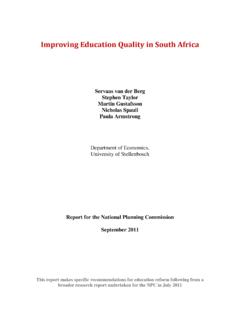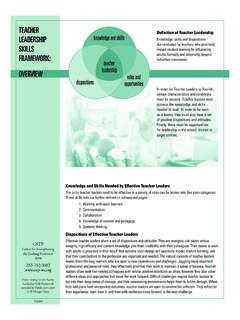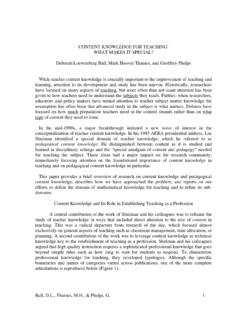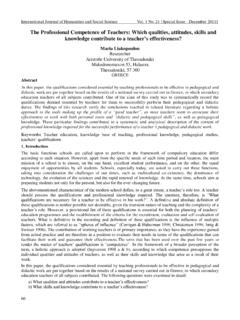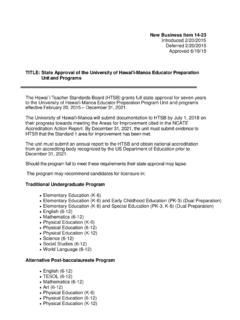Transcription of Improving Education Quality in South Africa
1 Improving Education Quality in South Africa Servaas van der Berg Stephen Taylor Martin Gustafsson Nicholas Spaull Paula Armstrong Department of Economics, University of Stellenbosch Report for the National Planning Commission September 2011. This report makes specific recommendations for Education reform following from a broader research report undertaken for the NPC in July 2011. TABLE OF CONTENTS. Introduction and diagnosis of low Education Quality .. 1. Six areas of recommendations: The 2. Key Proposals .. 4. 1. Developing Capacity within the Teaching Force .. 4. 2. School Management for Instructional Leadership .. 8. 3. Strengthening relationships of accountability and support amongst stakeholders throughout the school system .. 12. 4. Sharpening accountability through better information to parents and Education authorities.
2 14. 5. Improve understanding of the language issues .. 17. 6. Improve the Quality of ECD facilities .. 19. Conclusion .. 21. Appendix: Timeline for Phasing of Proposals .. 22. List of 23. 1. INTRODUCTION AND DIAGNOSIS OF LOW Education Quality . At the time of transition to democracy, fundamental reforms to the administration, governance and funding of Education were immediately necessary. A unified national department of Education was established while considerable responsibility was vested at the provincial level. Curriculum reform, although ultimately not uncontroversial, represented a strong break from previous arrangements and sought to advance critical thinking and problem solving. Public spending on Education has gone from being highly unequal on the basis of race under apartheid to being well targeted towards poor children.
3 Despite these mainly positive trends, a far more resilient legacy from the past has been the low Quality of Education within the historically disadvantaged parts of the school system. This seriously constrains the ability of the Education system to provide a pathway out of poverty for poor children. A cross-country comparison of educational attainment reveals a peculiar pattern specific to South Africa . The rate of attainment of levels of Education up until about 11 years is high in South Africa relative to other middle-income countries. Beyond 12 years of Education , however, South Africa s attainment rate is amongst the lowest of these countries. As far as access to Education is concerned, it would therefore appear that South Africa is doing well throughout most of the primary and secondary phases and poorly thereafter.
4 However, it is important to understand that high rates of grade progression despite a generally low Quality of schooling in the primary and early secondary phases leads to substantial drop-out prior to the standardised matric examination, failure to pass matric and failure to achieve a university endorsement all reasons for discontinuing Education . A closer analysis of access to Education in South Africa thus points to a deeper problem of Quality . In the recently conducted SACMEQ1 III (2007) survey of Grade 6 mathematics and reading, South Africa performed below most African countries that participated in the study. An alarmingly high proportion of Grade 6 learners have clearly not mastered even the most basic reading and numeracy skills. Using a categorisation of competency levels provided by SACMEQ.
5 As a benchmark, learners who have not reached Level 3 in the reading and mathematics tests can be regarded as functionally illiterate and functionally innumerate in the sense that they have not acquired the basic reading and numeracy skills necessary to function meaningfully in society (Shabalala, 2005: 222). Of the 15 Education systems that participated in the study, South Africa has the third highest proportion of functionally illiterate learners (27%), and the fifth highest proportion of functionally innumerate learners (40%). Figure 1 shows the proportions of functionally illiterate grade 6 learners within each SACMEQ country. 1. SACMEQ stands for Southern and East African Consortium for Monitoring Education Quality . 2. Figure 1: The prevalence of functional illiteracy in SACMEQ 2007.
6 100. 90. Proportion of grade 6 learners 80. 70. 60. 50. 40. Functionally Literate 30. Functionally Illiterate 20. 10. 0 Mauritius Tanzania Zanzibar Kenya Mozambique Malawi Namibia Zimbabwe Uganda Zambia Swaziland Botswana Lesotho South Africa Seychelles Within South Africa , the Quality of Education varies widely. Several authors characterise the South African school system as effectively consisting of two differently functioning sub-systems (Fleisch, 2008, Van der Berg, 2008, Taylor and Yu, 2009). The majority of children are located in the historically disadvantaged system, which still serves mainly black and coloured children. Learners in these schools typically demonstrate low proficiency in reading, writing and numeracy. The second sub-system consists mostly of schools that historically served white children and produces educational achievement closer to the norms of developed countries.
7 This second system serves mainly white and Indian children, although black and coloured middle class children are increasingly migrating to these schools. Literacy and numeracy testing within the National School Effectiveness Study (NSES) demonstrates that grade 5 learners in historically black schools are performing considerably worse on average than grade 3 learners in historically white schools (Taylor, 2011). Thus, by early primary school, children in historically black schools already carry an educational backlog equivalent to well over two years worth of learning. This motivates urgent attention to issues of Quality at the primary school level and even earlier in Early Childhood Development (ECD). SIX AREAS OF RECOMMENDATIONS: THE VISION. Developing capacity within the teaching force In order to achieve educational progress South Africa needs an institutional structure (encompassing teacher pay, bursary programmes and other interventions targeting existing teachers) that promotes good teaching and that attracts and retains the best teachers.
8 3. School Management for Instructional Leadership Effective schools require well selected individuals as principals together with management teams that understand and fulfil their roles as leaders of the curriculum, ensuring that an organised environment conducive to learning is present. Strengthening relationships of accountability and support amongst stakeholders throughout the school system What is envisaged is an institutional structure that is designed to avoid a breakdown in the implementation of policy due to a lack of capacity at any particular link in the chain, but that also enables capacity to be built up at levels of authority that are deemed to have an important role in the long run. Furthermore, an effective institutional structure will require a better alignment of the interests and incentives of stakeholders around the common goal of educational improvement.
9 In the case of districts, the McKinsey report (2007) offers a picture of how the mediating layer . of the district should function: (1) targeted support to improve practices within schools, (2). facilitation of communication and information sharing between the authorities and schools, and (3) facilitation of sharing of best practices between schools. Arguably in the case of South Africa the bulk of attention has focussed on the information sharing function, and mainly in a downward direction. Other ways of strengthening schools remain largely unexplored. Sharpening accountability through better information to parents and Education authorities South African schools require an educational assessment framework that (1) empowers parents with information on their child s performance, 2) informs teachers of correct assessment practices and highlights to them learning areas needing improvement, and 3) helps policy-makers and districts determine the rate and extent of progress in different sectors of the Education system, reasons for under-performance and which schools require specific types of interventions.
10 Improve understanding of the language issues Reducing the language disadvantages experienced by many learners will require language policies informed by a better understanding (through further research) of the mechanisms through which language factors affect learning outcomes and of when and how the switch to English as Language of Learning and Teaching (LOLT) should be implemented. Crucially though, the Quality of teaching English as First Additional Language (FAL) in the Foundation Phase will need to be improved. Improve the Quality of ECD facilities All South African children should have access to ECD facilities that are closely monitored and well supported ensuring a high Quality so as to give children a better foundation for learning upon entering primary school.

